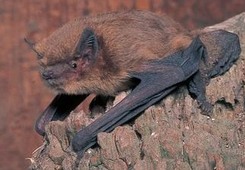

Biodiversity
Action
Plan

Bat species in Barnsley
Although the numbers of many species are now either stable or increasing, significant increases in bat numbers are needed for recovery to previous levels.
For this reason, all bat species present in Barnsley are a local priority. These are:
Common Pipistrelle
Soprano Pipistrelle**
Nathusius’ Pipistrelle
Daubenton’s
Brown long eared**
Natterer’s
Noctule**
Whiskered
Leisler’s*
Brandt’s
**Soprano Pipistrelle, Brown Long-eared, and Noctule bats are priority species in the UK BAP 2007 and remain Section 41 species of principal importance.
*Leisler’s bat is identified as Near Threatened under IUCN criteria.
See the Bat Conservation Trust website for descriptions of bat species.
Bats flying at dusk, over gardens, hedgerows, woodland and fields, catching insects on the wing for food, are something special.
Bat numbers plummeted across the country during the later 20th century and still need to recover to their former numbers.
Bats are intelligent, social mammals that can live for up to 40 years. Bats found in the UK sleep in the day and feed during the night, flying to find and catch their insect prey.
All UK bats are relatively small, ranging from our smallest, Common Pipestrelle, which weighs around 5 gram and has a wing-span of 20 centimetres to the 40 gram Noctule with a 40 centimetre wingspan.
Roosts. In summer, female bats form maternity roosts to have their young; in winter, bats use hibernation roosts.
Bats usually have one young a year. They spend the day in their roosts, which can be found in a variety of buildings, under bridges, in tunnels or shafts, or in holes in trees, depending on the species. Bats tend to return to the same sites each year.
Most summer colonies disperse in September and October, once the young bats are old enough to fly, and many bats hibernate at an alternative site from November to April. All bat roosts are protected by law, even during the months when they are unoccupied.
Feeding. Different species have different feeding behaviours. They may catch insects in flight, or pick them off the surface of open water, or from foliage or the ground.
In summer, bats emerge from their roosts at dusk to feed. The distances travelled to feeding sites very considerably, both within and between species. While some species feed close to their roost site, others fly long distances.
Bats frequently return to the same foraging sites, sometimes visiting the same site at the same time each night. However, a large number of feeding areas are needed throughout the year in response to insect availability.
For information on bat species, follow these links.
Bats eat vast numbers of insects each night in summer, including pests
Pipistrelles each consume up to 3000 midges or other small flies a night
Pipistrelle numbers dropped by an estimated 73% from 1978 to 1993
Bat species
South Yorkshire Bat Group is active in Barnsley undertaking research, monitoring roosts and promoting the conservation of bats and their habitats.
South Yorkshire Bat Group and the national Bat Conservation Trust are a good source of advice and information.